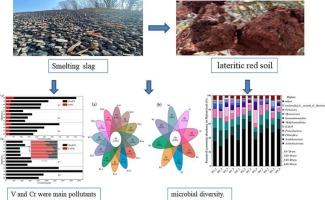Correlating microbial diversity patterns with V and Cr in blast furnace slag contaminated soil
IF 8
1区 环境科学与生态学
Q1 ENVIRONMENTAL SCIENCES
引用次数: 0
Abstract
This study systematically investigated the vertical variations of physicochemical properties, toxic elements and bacterial communities in soils surrounding a 32-year operational blast furnace slag stockpile site in Panzhihua, southwest of China, to explore the response of bacterial communities to the harsh environmental conditions. Soil in the region is substantially contaminated with multiple toxic elements. Both V and Cr were found in the 60–80 cm soil profile with average concentrations of 175.64 mg kg−1 and 566.87 mg kg−1, respectively. Topsoil (0–20 cm) and subsoil (20–80 cm) displayed distinct microbial community compositions. The predominant phyla in the topsoil included Actinobacteriota, Proteobacteria, Acidobacteriota, Chloroflexi, and Gemmatimonadota, whereas the subsoil primarily consisted of Actinobacteriota, Gal15, and Methylmirabilota. The diversity of bacteria was positively related with Mn, V, Pb, Zn and V(V) but negatively associated with MC. The microbial diversity in the topsoil was influenced by Mn and V, while microbial communities in the subsoil were impacted by MC. Functional annotation based on PICRUSt2 and FAPROTAX showed organic carbon oxidation was their main energy acquisition strategy, OM, MC, Mn, V(V) and Fe were the main factors shaping microbial community structure, and trace metals were the core factors regulating metabolic networks. These results enhanced our understanding of distinct heterogeneity of microbial communities influenced by the presence of V and Cr in soil environments.

高炉渣污染土壤中微生物多样性与V、Cr的关系
本研究系统研究了攀枝花运行32年的高炉矿渣堆场周边土壤理化性质、有毒元素和细菌群落的垂直变化,探讨了细菌群落对恶劣环境条件的响应。该地区的土壤受到多种有毒元素的严重污染。60 ~ 80 cm土壤剖面中,V和Cr的平均含量分别为175.64 mg kg - 1和566.87 mg kg - 1。表层土壤(0 ~ 20 cm)和底土(20 ~ 80 cm)微生物群落组成差异显著。表层土壤中主要的菌门有放线菌门、变形菌门、酸杆菌门、绿菌门和双胞菌门,而下层土壤中主要的菌门有放线菌门、Gal15门和甲基mirabilota门。细菌多样性与Mn、V、Pb、Zn和V(V)呈显著正相关,与MC呈显著负相关。表层土壤微生物多样性受Mn和V的影响,而下层土壤微生物群落受MC的影响。基于PICRUSt2和FAPROTAX的功能注解表明,有机碳氧化是其主要的能量获取策略,OM、MC、Mn、V(V)和Fe是形成微生物群落结构的主要因素。微量金属是调节代谢网络的核心因子。这些结果增强了我们对土壤环境中V和Cr的存在对微生物群落的明显异质性的理解。
本文章由计算机程序翻译,如有差异,请以英文原文为准。
求助全文
约1分钟内获得全文
求助全文
来源期刊

Science of the Total Environment
环境科学-环境科学
CiteScore
17.60
自引率
10.20%
发文量
8726
审稿时长
2.4 months
期刊介绍:
The Science of the Total Environment is an international journal dedicated to scientific research on the environment and its interaction with humanity. It covers a wide range of disciplines and seeks to publish innovative, hypothesis-driven, and impactful research that explores the entire environment, including the atmosphere, lithosphere, hydrosphere, biosphere, and anthroposphere.
The journal's updated Aims & Scope emphasizes the importance of interdisciplinary environmental research with broad impact. Priority is given to studies that advance fundamental understanding and explore the interconnectedness of multiple environmental spheres. Field studies are preferred, while laboratory experiments must demonstrate significant methodological advancements or mechanistic insights with direct relevance to the environment.
 求助内容:
求助内容: 应助结果提醒方式:
应助结果提醒方式:


